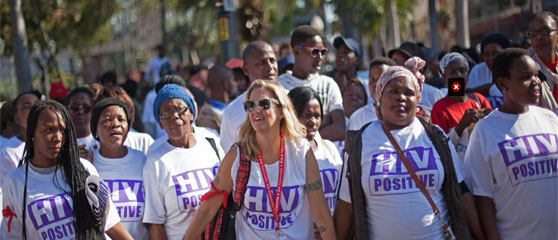As advocates, officials, and health care professionals gather in Durban, South Africa this week for the International AIDS Society’s AIDS2016 conference, another group of people have moved out—and not by choice. In an attempt to make Durban appear more attractive to attendees of one of the world’s largest conferences on any global health or development issue, homeless people, drug dealers, and sex workers were removed from the central city. In other words, the very people who are at increased risk of contracting HIV and not receiving treatment are now even more vulnerable, and essentially rendered invisible.
This article was first published by Open Society Foundations (OSF). You can read the original here.
The sanitization of the city set the tone for the conference. For instance, organizations like UNAIDS have called for increased investment in harm reduction and HIV prevention measures for people who use drugs—calls that are echoed around the globe by civil society and activists. And indeed, one of the AIDS2016 conference’s stated objectives is “promoting HIV responses that are supported by and tailored to the needs of at-risk populations or people living with HIV,” including people who use drugs.
Yet people who use drugs are largely ignored inside the conference. What’s more, of the 446 abstracts that contain the keywords “harm reduction,” “drug use,” and “drug policy,” only six were accepted for oral presentation and three for poster discussion—an exceedingly small number considering how important this population is considered by those trying to end AIDS by 2030.
Quite literally, the rights of people who use drugs, and the policies that restrict access to harm reduction and health services, are not on the agenda at AIDS2016. Even if one counts the events held by people who use drugs and harm reduction activists in the Global Village, there are fewer than 40 that focus on these areas. If it wasn’t for the last-minute efforts of a few under-resourced individuals working for supportive organizations, there would literally be no place for people who use drugs to meet and discuss their issues, or to receive the life-saving harm reduction commodities they need.
Due to this last-minute push, organizers were able to tick the “inclusive” box. But while we have a place to congregate in the Global Village, people who use drugs are still left out of the conference’s main proceedings.
To some degree, this is par for the course: in HIV/AIDS advocacy, people who use drugs are often talked about, but seldom visible. UNAIDS produces excellent reports showing the importance of supporting drug users in reaching HIV reduction targets. They call for increased investment and access to harm reduction, the decriminalization of drug use, and the promotion of drug users’ rights. Yet UNAIDS has no dedicated focal point on HIV and drug use. The organization has announced that funding for the UN Office on Drugs and Crime’s HIV program will end, and their latest calculation of resource needs excludes antiretroviral therapy and 75 percent of people who inject drugs.
The HIV epidemic forced the world to pay attention to the needs of people who use drugs, because their vulnerability to HIV made the world in general more vulnerable to the disease. Through this self-serving benevolence, people who use drugs were declared an essential target for HIV interventions, and it was finally acknowledged that these people were being denied the rights that so many take for granted. Yet 40 years later, recognition of the needs of people who use drugs are still almost entirely tied to efforts to fight HIV.
As such, advocates for the health and human rights of people who use drugs have come to rely on HIV funding to do their work. Harm reduction as a philosophy that could benefit all drug users has been reduced to a set of HIV interventions. Therefore, since drug users are only visible through the lens of HIV prevention, it is very concerning that the world’s biggest gathering of HIV scientists, policy makers, health professionals, and activists has kept drug users, and even the narrowest definition of harm reduction, out of the main proceedings. People who use drugs are becoming invisible. But of course, we are still here. It is the world that is choosing to turn a blind eye.


